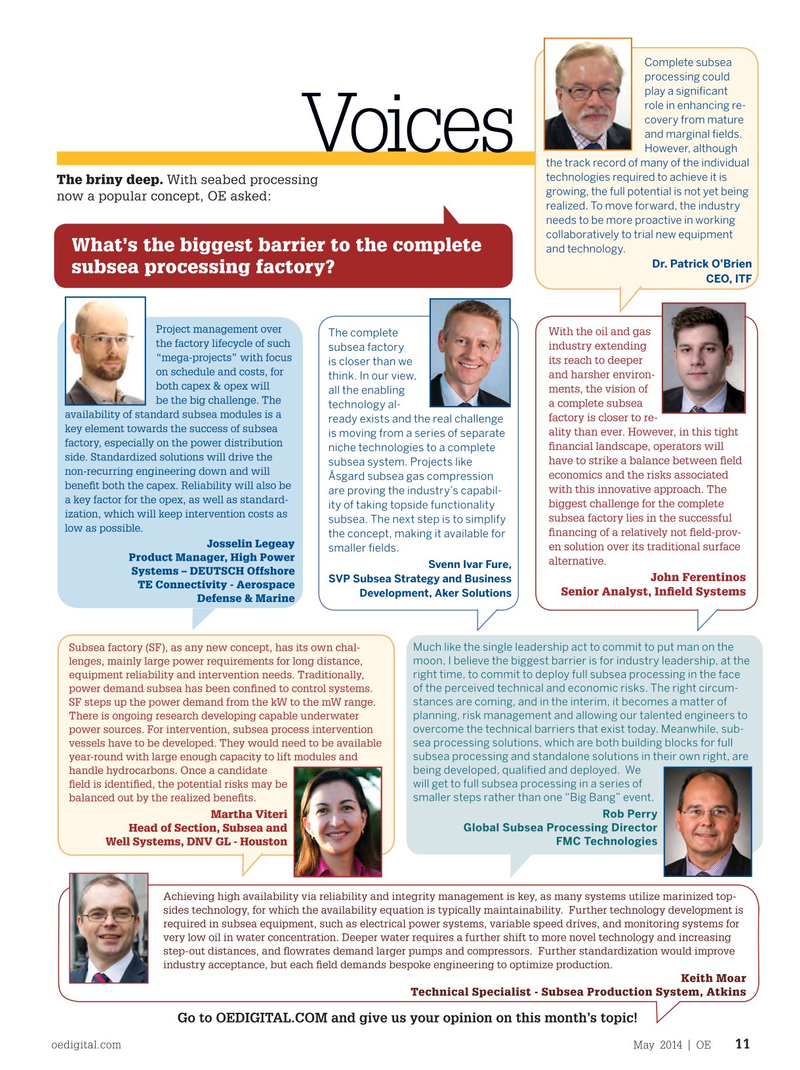
Page 9: of Offshore Engineer Magazine (May/Jun 2014)
Read this page in Pdf, Flash or Html5 edition of May/Jun 2014 Offshore Engineer Magazine
Complete subsea processing could play a signi? cant role in enhancing re- covery from mature and marginal ? elds. Voices
However, although the track record of many of the individual technologies required to achieve it is
The briny deep. With seabed processing growing, the full potential is not yet being now a popular concept, OE asked: realized. To move forward, the industry needs to be more proactive in working collaboratively to trial new equipment
What’s the biggest barrier to the complete and technology.
Dr. Patrick O’Brien subsea processing factory?
CEO, ITF
Project management over
With the oil and gas
The complete the factory lifecycle of such industry extending subsea factory “mega-projects” with focus its reach to deeper is closer than we on schedule and costs, for and harsher environ- think. In our view, both capex & opex will ments, the vision of all the enabling be the big challenge. The a complete subsea technology al- availability of standard subsea modules is a factory is closer to re- ready exists and the real challenge key element towards the success of subsea ality than ever. However, in this tight is moving from a series of separate factory, especially on the power distribution ? nancial landscape, operators will niche technologies to a complete side. Standardized solutions will drive the have to strike a balance between ? eld subsea system. Projects like non-recurring engineering down and will economics and the risks associated
Åsgard subsea gas compression bene? t both the capex. Reliability will also be with this innovative approach. The are proving the industry’s capabil- a key factor for the opex, as well as standard- biggest challenge for the complete ity of taking topside functionality ization, which will keep intervention costs as subsea factory lies in the successful subsea. The next step is to simplify low as possible.
? nancing of a relatively not ? eld-prov- the concept, making it available for
Josselin Legeay en solution over its traditional surface smaller ? elds.
Product Manager, High Power alternative.
Svenn Ivar Fure,
Systems – DEUTSCH Offshore
John Ferentinos
SVP Subsea Strategy and Business
TE Connectivity - Aerospace
Senior Analyst, In? eld Systems
Development, Aker Solutions
Defense & Marine
Much like the single leadership act to commit to put man on the
Subsea factory (SF), as any new concept, has its own chal- moon, I believe the biggest barrier is for industry leadership, at the lenges, mainly large power requirements for long distance, right time, to commit to deploy full subsea processing in the face equipment reliability and intervention needs. Traditionally, of the perceived technical and economic risks. The right circum- power demand subsea has been con? ned to control systems. stances are coming, and in the interim, it becomes a matter of
SF steps up the power demand from the kW to the mW range. planning, risk management and allowing our talented engineers to
There is ongoing research developing capable underwater overcome the technical barriers that exist today. Meanwhile, sub- power sources. For intervention, subsea process intervention sea processing solutions, which are both building blocks for full vessels have to be developed. They would need to be available subsea processing and standalone solutions in their own right, are year-round with large enough capacity to lift modules and being developed, quali? ed and deployed. We handle hydrocarbons. Once a candidate will get to full subsea processing in a series of ? eld is identi? ed, the potential risks may be smaller steps rather than one “Big Bang” event.
balanced out by the realized bene? ts.
Martha Viteri Rob Perry
Head of Section, Subsea and Global Subsea Processing Director
Well Systems, DNV GL - Houston FMC Technologies
Achieving high availability via reliability and integrity management is key, as many systems utilize marinized top- sides technology, for which the availability equation is typically maintainability. Further technology development is required in subsea equipment, such as electrical power systems, variable speed drives, and monitoring systems for very low oil in water concentration. Deeper water requires a further shift to more novel technology and increasing step-out distances, and ? owrates demand larger pumps and compressors. Further standardization would improve industry acceptance, but each ? eld demands bespoke engineering to optimize production.
Keith Moar
Technical Specialist - Subsea Production System, Atkins
Go to OEDIGITAL.COM and give us your opinion on this month’s topic!
oedigital.com May 2014 | OE 11 011_OE0514_voices.indd 11 4/18/14 5:53 PM

 8
8

 10
10